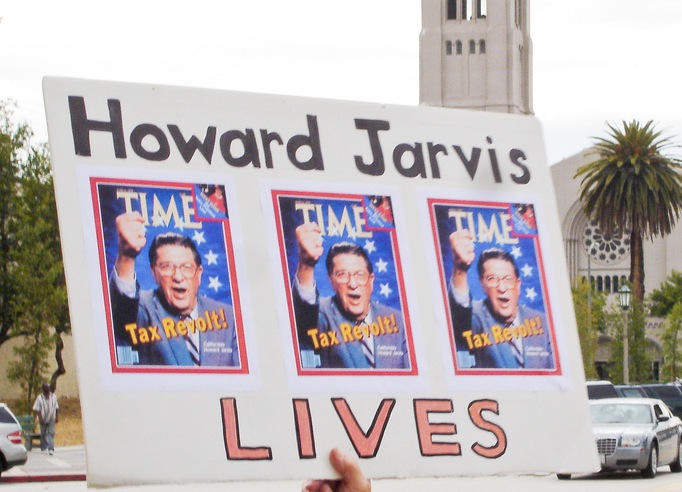
In the mid-1970s, when I was a law student at Pepperdine and California state chairman of a conservative volunteer group, the Young Americans for Freedom, we began to get visits at the YAF offices from a brusque older gentleman named Howard Jarvis.
I had heard Jarvis during his appearances on Ray Briem’s late-night talk show on KABC radio, on which Jarvis made the case that real property taxes were too high and that somebody damn well ought to do something about them. When he started dropping by our offices, at 1250 Wilshire Boulevard, just west of downtown Los Angeles, he emphasized how important it was that our members—college-age students—know all about real property taxes and help him circulate petitions to qualify a ballot proposition to lower them. When I invited Howard to speak to the University of Southern California chapter of YAF in 1977, he readily agreed—and managed to convince about 20 clueless teenagers that they should be concerned about real property taxes that none of them even needed to pay.
The story of Howard Jarvis, when it is recounted on occasions like this week’s 35th anniversary of Proposition 13, is rightly remembered as the enormous political moment it was, when California and the nation were turned upside down by the largest tax cut in state history, giving momentum to Reagan’s historic election as president two years later and changing politics and government in the Golden State forever.
What is forgotten is that Jarvis was in most ways an ordinary man and very much a person of a time and place: Los Angeles of the 1970s. He could drop by our office because he was usually around. He lived not too far away, on Crescent Heights Boulevard, and had an office in Mid-Wilshire at the Apartment Association of Los Angeles.
And his story, whether you are a fan of Prop 13 or not, is a timely reminder that, if you have a powerful idea and a willingness to reach out to people, you don’t have to be a practiced politician like Jerry Brown or Pete Wilson, a Hollywood star like Ronald Reagan or Arnold Schwarzenegger, or even a cunning strategist like Richard Nixon to leave a legacy.
I went to work for Jarvis and was with him in 1978 as he convinced Californians to adopt Prop 13. I remember both the public Jarvis—a passionate man, with more than a little flair—and the private Jarvis, who lived a quiet and typical Los Angeles life. Indeed, the informality and open-mindedness of that time and place—a Los Angeles where you’d think nothing of starting a conversation with a stranger over a big idea, or dropping by an office without an appointment—helped make Prop 13 possible.
Howard was a penny pincher who wore cheap suits he bought on sale at the Zachary All discount store at 5467 Wilshire, not too far from his home. Howard’s wife, Estelle, once told me she didn’t want Howard in expensive suits, because when giving speeches he often set them on fire by absent-mindedly sticking his lit corn-cob pipe in one of the pockets. I can attest to this, because after I graduated from law school and became a full-time aide to Jarvis, I not only watched him do this once but also discovered that more than one of his business suits from Zachary All had those familiar burn marks at the pockets.
When he got excited, Jarvis would puff harder on his pipe, and this created a lot of excess “tobacco juice.” During one unfriendly interview with a reporter, Jarvis got agitated and started puffing hard. At one point, sitting behind his big, false desk with no drawers, Jarvis leaned forward and spit some of the excess tobacco juice into a waste can. Jerry Carroll, on the other side of the desk without benefit of a full view, wrote in a 1994 San Francisco Chronicle story that at one point in an interview Jarvis, “jerked opened a drawer in his desk, spit into it and slammed it shut.”
Howard was a man of simple tastes. He used to tell me that his favorite meal was Estelle’s corn soup. While I was at Jarvis’ home one time I happened to observe the preparation of Howard’s favorite meal, which I was surprised to learn consisted of one can of Del Monte creamed corn mixed into a cup of whole milk, simmered to just below boiling and plopped into a bowl.
His taste in beverages was ordinary too. He liked vodka—“the cheaper the better” he told one of my colleagues during a liquor store stop. And he didn’t make a big deal out of when to drink it. I once carried Jarvis’ briefcase and accompanied him to an interview with a reporter in a suite at the Ritz-Carlton Hotel in Boston. The only thing in his briefcase that day was his bottle of vodka. I call that flair.
It is hard to picture California’s leaders today wearing thrifty suits, ordering “the cheapest vodka ya got” at their trendy wine bars, or getting a kick out of the simplest of meals. But trading up to premium-brand cocktails doesn’t seem to have helped our politicians accomplish anything too extraordinary.
During the Prop 13 campaign in June 1978, just about every politician, business association, and labor union warned of dire consequences for the state if it were enacted. The measure had two things going for it: the support of an over-taxed electorate, and the determination of an otherwise ordinary guy named Howard Jarvis. When the votes were counted, the measure passed by 2-to-1 statewide. It lowered the property tax burden on average Californians by about 60 percent and, according to research by the economist Dr. Arthur Laffer, unleashed an unprecedented economic expansion. Overall property tax revenues came back in six years.
I am well aware that not everyone sees Prop 13 the same way. Californians are still arguing about it 35 years later. But the polls show that ordinary Californians still side with Jarvis. I think one reason for that is that he lived among them.





Send A Letter To the Editors